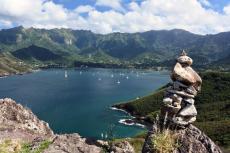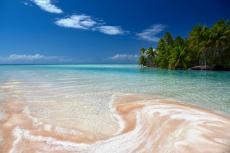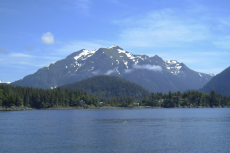For the bona fide traveller, or should I say, the thrill-seeker, the thought of heading off to the far side of the world is enticing. Ponder this for a moment: Have you ever heard of the Marquesas Islands?
Contributed by
Factfile
REFERENCES:
Delrieu-Trottin, E., Williams, J.T., Bacchet, P., Kulbicki, M., et al (2015). “Shore fishes of the Marquesas Islands: An updated checklist with new records and new percentage of endemic species.” Check List. 11 (5). https://www.biotaxa.org/cl/article/view/11.5.1758
Galzin, R., Duron, S.D., Meyer, J.Y. (2016). Biodiversité terrestre et marine des îles Marquises. Paris: Société Française d’Ichtyologie
Ottino, P., Bergh-Ottino, M.N. (1991). Hiva Oa: Images d’une mémoire océanienne. Tahiti: Département Archéologie, Centre Polynésien des Sciences Humaines.
Located between 7°50 S and 10°35 South latitude, and 139°23 W and 140°50 West longitude, this archipelago is home to the most distant specks of land, far from anywhere on the planet: approximately 4,700km to the tip of Baja California, 6,300km to Peru, 7,300km to Australia and 88,00km to Kamtchatka in the Russian Far East. Hawaii lies about 3,400km to the northeast, Galapagos about 5,300km to the east, Rapa Nui (Pascua Island) about 3,500km to the southeast, and Tahiti around 1,400km to the southwest.
The 12 main islands of the Marquesas Archipelago represent a land surface of 1,052 sq km, aligned on a southeast-northwest axis of 350km. Ranging from 1.1 to 5.5 million years old, the oldest islands such as Eiao and Hatu Tu are found in the northwestern part of the archipelago, and the youngest islands such as Hiva Oa and Fatu Hiva are found in the southeastern part.
A northern group of six islands cluster around Nuku Hiva (including Eiao, Hatutu, Ua Huka, Ua Pou and Motu Iti), while a southern group of islands surrounds Hiva Oa (including Tahuata, Motane, Fatu Huku and Fatu Hiva). Nuku Hiva, the biggest island, measures 340 sq km, with a summit at 1,224m above sea level.

Geology
The Marquesas Islands are an atypical geological hotspot, with islands moving from the southeast to the northwest. This matches the movement of the Pacific Plate of 10.5cm to 11cm per year. This group of volcanic islands rises 4,000m above the seafloor, with an ocean crust aged 59 to 49 million years (in the Paleocene-Eocene epoch).
The latter, which is 800km wide, is limited by two major fracture zones oriented at N100°W with the Galapagos Fracture Zone (GFZ) in the north and the Marquesas Fracture Zone (MFZ) in the south. Drifting away from a fixed hotspot, the islands sink slowly by thermic subsidence, to eventually become atolls.
A number of submarine mounts have been identified in the southern part of the archipelago. Submarine reef flats have been located between the depths of 40m to 130m around Hiva Oa. The petrographic diversity of the islands is due to the Marquesan magmatic plume, which is made up of two distinct filaments of different isotopic composition: tholeiitic basalts, which are saturated or oversaturated in silica (peridotites); and alkaline basalts, which are under-saturated in silica (pyroxenites) or very undersaturated (basanites).

Volcanoes
Most of the islands are shield volcanoes. These have evolved into huge calderas, which in turn have been destroyed into halves by the action of marine currents. Once 20km in diameter, the Eiao and Nuku Hiva calderas have collapsed in their southern and southeastern parts. Exposed to a different current, Fatu Hiva has collapsed in its western part, showing a concave side to the west.

Marine climate
The Marquesas Islands are bathed by the east-to-west-flowing South Equatorial Current (SEC) in the north, and by the west-to-east-flowing South Equatorial Counter Current (SECC) in the south. However, the archipelago is mostly under the influence of the SEC, which is helped by the easterly trade winds.
Located in the subtropical zone, the waters of the Marquesas Islands are rich in nutrients. The southern frontier of the archipelago’s waters is deeply subjected to the equatorial, upwelling, deep-ocean waters coming to the surface, which favour the development of phytoplankton. This means that there is intense biological activity here, in comparison to the surrounding oceanic waters.
The elevated phytoplanktonic biomass has a seasonal cycle marked by the El Nino–La Nina phenomenon. Average seawater temperatures range from 27°C to 28°C. With a not-so-humid tropical climate, the rainy season takes place from July to August. An oasis of life in the middle of an oceanic desert, the Marquesas are dispersed over a marine surface of 100,000 sq km.

History
Although archaeological research suggests that the islands were colonised between 150 B.C. and 100 A.D. by voyagers from West Polynesia, it turns out, around 1500 B.C., the presence of populations of the Lapita ceramic culture was already evident in the region of Fiji, Samoa and Tonga.

There is no doubt that the islands’ ancestors were of Melanesian origin, even beyond Southeast Asia and Taiwan. The cultivation of breadfruit as well as irrigated terraces of taro plants are predominant. The word kaikai, which means “food” in Marquesas, is the same word used in Papua New Guinea and Melanesia.
For the Europeans though, the official discovery of the islands was made by Spanish navigator Álvaro de Mendaña, who sailed by them on 21 July 1595. Landing in Fatu Hiva, he named them the Marquesas Islands in the honour of Marquis de Cañete, the then Spanish viceroy of Peru.
American whalers visited in the 18th and 19th centuries. Among them was Herman Melville on the whaleboat Acushnet, who deserted the ship at Nuku Hiva on 9 July 1842. After a memorable escape with his friend “Toby” (Richard Tobias Greene), he took refuge in the valley of Taipivai, where he lived with the cannibals for three weeks. His adventures were relayed in his book, Typee (Taïpi): A Peep at Polynesian Life (published in 1846), which ended in a thrilling escape.
More recently, Robert Louis Stevenson, the Scottish novelist who wrote the book, In the South Seas (published posthumously in 1896), left tracks as well. The French post-impressionist artist Paul Gauguin lived and died in Hiva Oa in 1903. Later on, talented Belgian singer Jacques Brel, remembered for his song “Les Marquises,” also lived on the island for three years and died in Atuona in 1978.

Dive operator
Looking for adventure and a new life, as Norwegian adventurer Thor Heyerdahl did before him in 1937, Xavier Curvat (also known as “Pipapo”) left France in 1980 at the age of 20. With a work certificate as a cook, he booked a flight to Tahiti, where he soon met Marquesan people. He boarded a cargo-passenger boat for a memorable four-day journey on deck. Disembarking at Atuona, Hiva Oa, he crossed the island on foot to reach the valley of Puamau.
A spearfishing enthusiast, he dedicated himself to fishing and hunting, catching turtles as well. He planted an orchard, purchased a horse, and sold his products around the village. Building a dugout canoe, he ventured into lobster fishing. Three years later, a friend invited him to take a sailboat from Tahiti to the Tuamotu and the Marquesas. This would be his first encounter with sperm whales in the open ocean. He ended up marrying a Marquesan woman.
In 1990, he was initiated into scuba diving, with tanks and an old compressor. Based in Nuku Hiva, together with a young divemaster, he discovered an islet at the exit of Taiohae Bay, which turned out to be a haven for hammerhead sharks. The idea of a dive centre emerged slowly, but he needed to get certified and pass all the levels first. In 1993, he opened Centre de Plongée Marquises (dive centre) and refitted the hull of an old wreck, which he transformed into a dive boat.
He then organised interisland transport for the locals, attracting Nicolas Hulot of the French TV programme Ushuaia (1994), which propelled him to national fame. Later on, he operated dive charters in the northern islands, opening a new dive centre on Hiva Oa. When his wife left him after 11 years, he closed his operations in Atuona and concentrated on Nuku Hiva. He now specialises in scientific research, millionaires’ boats, shoots for television, American groups, and sometimes works as a consultant.

Biodiversity
A hotspot with high biodiversity underwater, the Marquesas Islands are a centre of endemism. In 1973, Mission IX of the National Museum of Natural History in Paris established a list of 391 species of fish in the archipelago. In 1978, the American ichthyologist John Randall evaluated the endemism to be 10%. In their expedition of 1998-99, Randall and Earle published a list of 415 coastal fishes (2000).
Following the Expedition Pakaihi I Te Moana, which was conducted in 2011 in the Marquesas Islands, the latest research of Frenchman Delrieu-Trottin (2015), brought the number to 495 species, with 68 endemic species (or 13,7%), which is more than the other archipelagos of French Polynesia, but less than Hawaii (20%), Galapagos (17%) or Pascua Island (22%).

Fish life. The fish community in the Marquesas Islands is different from those at other archipelagos in French Polynesia and the South Pacific. The presence of strong upwellings around the islands triggers an important primary production and may explain the absence of constructed coral reefs. Nevertheless, marine life includes 24 species of hard corals, 38 species of sponges, 70 species of echinoderms and 629 species of molluscs (61 species being endemic to the Marquesas).
Marine mammals. Marine mammals are also well represented in the Marquesas, with 16 species having been identified. The four coastal species include the spinner dolphin (Stenella longirostris), pantropical spotted dolphin (Stenella attenuata), common bottlenose dolphin (Tursiops truncatus), and melon-headed whale (Peponocephala electra). Pelagic dolphins include the Risso’s dolphin (Grampus griseus), Cuvier’s beaked whale (Ziphius cavirostris), sperm whale (Physeter macrocephalus), pygmy or dwarf sperm whale (Kogia sima), humpback whale (Megaptera novaeangliae), false killer whale (Pseudorca crassidens), orca (Orcinus orca), and pygmy killer whale (Feresa attenuata).

Sharks. Twenty species of sharks are also noted in the Marquesan waters, including the classic reef sharks: grey, whitetip, blacktip reef and blacktip (Carcharhinus limbatus), but also the silvertip shark (Carcharhinus albimarginatus), silky shark (Carcharhinus falciformis), sicklefin lemon shark (Negaprion acutidens), oceanic whitetip shark (Carcharhinus longimanus), tiger shark (Galeocerdo cuvier), blue shark (Prionace glauca), shortfin mako shark (Isurus oxyrhinchus), scalloped hammerhead shark (Sphyrna lewini), great hammerhead shark (Sphyrna mokarran), tawny nurse shark (Nebrius ferrugineus), whale shark (Rhincodon typus), and two species of thresher shark (Alopias pelagicus and Alopias vulpinus).

Manta rays. The two species of manta rays that are currently seen include the giant oceanic manta ray (Mobula birostris) and the reef manta ray (Mobula alfredi). The smaller sea devil or sicklefin devil ray (Mobula tarapacana) is also found. Manta rays were traditionally speared with a harpoon by Marquesas fishermen in Nuku Hiva and Tahuata, during village festivals, until the year 2000.
Diving
Inconspicuously, the Centre de Plongée Marquises was hidden behind the flamboyant clothing and souvenir shop of Marie, right beside the fisherman's harbour. The red and ochre-coloured dive boat Makuita was moored at the dock, where I met Jules, a 20-year-old with big curly hair. “I am the deckhand and son of Xavier,” he said, reaching out his fist in a fashionable Covid-19 salute.

Dive centre owner Pipapo showed up a little bit later, a weathered 61-year-old mariner with spotted skin and tattoos on his leg and arms, Marquesan-style. Four other divers joined us on this dive trip.
Cap Martin
We then headed out to Cap Martin (also known as Cape Tikapo), which was located on the southeastern tip of Nuku Hiva’s caldera.
Half an hour into the trip, the boat ride was rough, the sea foaming around us with lots of waves. The island’s rugged coast was carved by basaltic points and coves, with its interior covered in jungle, rising steeply behind them.

“The plan is to dive the protected side of the cape—although the swell is conspicuous underwater,” said Pipapo in his briefing on deck, but he would not be diving with us. We divers were on our own. Three of the divers would team together, and I would dive with a diver named Alexandra. “I’ll follow you,” she warned. The visibility struck me as being rather misty, but fish life was plentiful.
There were large schools of paddletail snappers (Lutjanus gibbus) and sleek unicornfish (Naso hexacanthus). Compact shoals of bluefin jacks (Caranx melampygus) mixed with giant jacks (Caranx ignobilis) and rainbow runners (Elagatis bipinnulata). I saw moving clouds of bluestripe snapper (Lutjanus kasmira), with the occasional red snapper (Lutjanus bohar). A squad of oriental bonitos (Euthynnus affinis) zoomed past, and a silver doublespotted queenfish (Scomberoides lysan) followed suit. This was a fountain of life indeed!

As we neared the point, at a depth of 35m, I felt the current dragging us to the other side. A big octopus stared at me from the comfort of its hole. I gave the signal for a turnaround. The visibility was really affected by lots of plankton, an effect of the upwelling. The water temperature was a balmy 27°C, and a wetsuit was not even necessary. Lesser frigate birds (Fregata ariel) hovered above, as we surfaced. “At the right time, early in the year in January to February, one may witness an important gathering of melon-headed whales at Cap Martin,” said Pipapo with a smile.

The Makuita headed back to the caldera of Taiohae. Our interval time would be spent on the protected side of Matauapuna Island. Homemade banana cake was served with tea.
La Sentinelle aux Marteaux
La Sentinelle aux Marteaux was our next dive site. The name referred to a small island that stood like a sentinel at the eastern entrance of the bay. Another sentinel stood to the west, which was Motu Nui.
Visibility did not improve on the second dive, with a sulfur-yellow layer in the water at 25m. Alexandra joined the others this time, and I was on my own, happy as can be with my camera buddy!

I chose to stay above in the 15m zone, where the clarity of the water was better. A good decision, for I met four scalloped hammerhead sharks (Sphyrna lewini), with two approaching close enough for decent shots. One of them was a pregnant female, which had bite marks on the left pectoral fin—the work of an aggressive male. This was what the dive site was famous for: the presence of hammerhead sharks, with a 70 percent chance of an encounter.

Other species seen here included convict tangs (Acanthurus triostegus); whitecheek surgeonfish (Acanthurus nigricans); Tahiti butterflyfish (Chaetodon trichrous), which is endemic to French Polynesia; tarry hogfish (Bodianus bilunulatus); and large peacock groupers (Cephalopholis argus). Cute, blacktip groupers (Epinephelus fasciatus), red in colour, were seen everywhere. An inquisitive masked moray eel (Gymnothorax breedeni), which was brown with a black stripe across its face, peeked out of its hole with a cool glance. A school of barracudas swirled by, and imposing great barracudas showed up during the dive.

Absolutely stunning was the Marquesan flower sea urchin (Toxopneustes maculatus), which was spherical in shape and white all over, with concentric purple rings, sometimes forming a star pattern. It was “non-venomous and endemic to the Marquesas,” confirmed Pipapo. Anywhere else, the genus was highly toxic.

Sea caves
A number of sea caves could be found in Nuku Hiva. These could be pretty hectic due to swell and strong currents. Ekamako Cave was 7m wide, 3m high and 8m deep. It used to be the hiding place of warriors. Nowadays, it was better known for stingrays (Himantura fei), whitetip reef sharks (Triaenodon obesus), three species of spiny lobsters (Panulirus femoristriga, Panulirus homarus and Panulirus penicillatus), and slipper lobsters (Parribacus scarlatinus or Scyllarides haanii). A system of four caves was located on Nuku Hiva’s southern coast. At a depth of 22m to 24m, these were the refuge for marbled rays (Taeniura meyeni), grey reef sharks (Carcharhinus amblyrhynchos), and blacktip reef sharks (Carcharhinus melanopterus).
Topside excursions

Due to the lack or scarcity of customers during these days of the coronavirus pandemic, non-diving days were used for local topside excursions. A short distance from Taiohae town, one could take an excursion to the Tehaatiki viewpoint, which overlooked Matauapuna Island, known as “Sentinelle de l’Est,” with commanding views over the entrance of the bay of Taiohae. It was an opportunity to observe seabirds such as the white tern (Gygis alba) and sooty tern (Onychoprion fuscatus), or the white-tailed tropicbird (Phaethon lepturus), flying above.

Other excursions required transport (hire a car, unless you want to walk or hitchhike), such as Hatiheu Bay on the northeastern coast, past Taïpivai where Melville lived. From Hatiheu, a nice trail led eastward over a pass, to Anaho Beach and Haatuatua Beach, which was well worth doing for the panoramic views. Before you reach Hatiheu, you can stop by the archaeological sites of Kamuihei and Tahakia, where you can marvel at ancient “tohua” (stone platforms for festivities) such as “me’ae,” a religious sanctuary; “paepae,” a dwelling of terraces and gardens for the cultivation of taro plants; as well as petroglyphs on boulders and “tikis.” Let me explain what a tiki is…
A tiki is an anthropomorphic figure carved in stone that depicts a mythical supernatural being, often a high-ranking warrior or chief, elevated to deity status. In Taaoa (Hiva Oa), a one-metre-tall tiki with huge globe-like eyes and a wide, grinning mouth was offered human sacrifices during religious rituals, which took place on a dedicated stone platform or “me’ae.” Ritual cannibalism followed in order to absorb the “mana,” or life force, of the deceased. Among the animals carved into the stone, the sea turtle was deeply venerated.

More diving

Another dive day brought me back to La Sentinelle aux Marteaux dive site, with better visibility and a chance of close encounters with various species of fish, including the orange-band surgeonfish (Acanthurus olivaceus), fire surgeonfish (Acanthus pyroferus), manybar goatfish (Parupeneus multifasciatus), blacktail snapper (Lutjanus fulvus), and Marquesan parrotfish (Scarus koputea), which is endemic.

At the dive site of Motu Nui, or La Sentinelle de l’Ouest, the waters were very full of plankton, and I felt as if I was swimming through fog. Nonetheless, I came across two species of surgeonfish, the Marquesan surgeonfish (Acanthurus reversus), which is endemic; and the very pretty bluespotted or striped-fin surgeonfish (Ctenochaetus marginatus).
Freshwater streams

One local curiosity drew my attention to the freshwater streams of Taïpivai, Hatiheu and Aakapa Bay on Nuku Hiva Island: the presence of two freshwater eel species, Anguilla obscurus and Anguilla marmorata. I have seen these eels much farther south on Fatu Hiva Island. It seemed that the origin of these eels was in Vanuatu in the western Pacific, from where they migrated most likely with the South Equatorial Counter Current.
Afterthoughts
If the Marquesas Archipelago is indeed a “booby trap” for tourists searching for a lost Eden or an ancestral culture that values ruthless warriors with cannibalistic rituals, it may also be a potentially enormous one for divers, with its rich and unique marine biodiversity. Far from the postcards of Tahiti or the idyllic lagoons of Tuamotu, with its crystal-clear waters, the Marquesas Islands require an ability to adapt to the circumstances—from various sea conditions to underwater visibility affected by equatorial upwelling. Just remember Jacques Brel’s song, “Gémir n’est point de mise aux Marquises.” There is no point to moaning in the Marquesas. ■
With a background in biology and geology, French author, cave diver, naturalist guide and tour operator Pierre Constant is a widely published photojournalist and underwater photographer. For more information, please visit: calaolifestyle.com.




































